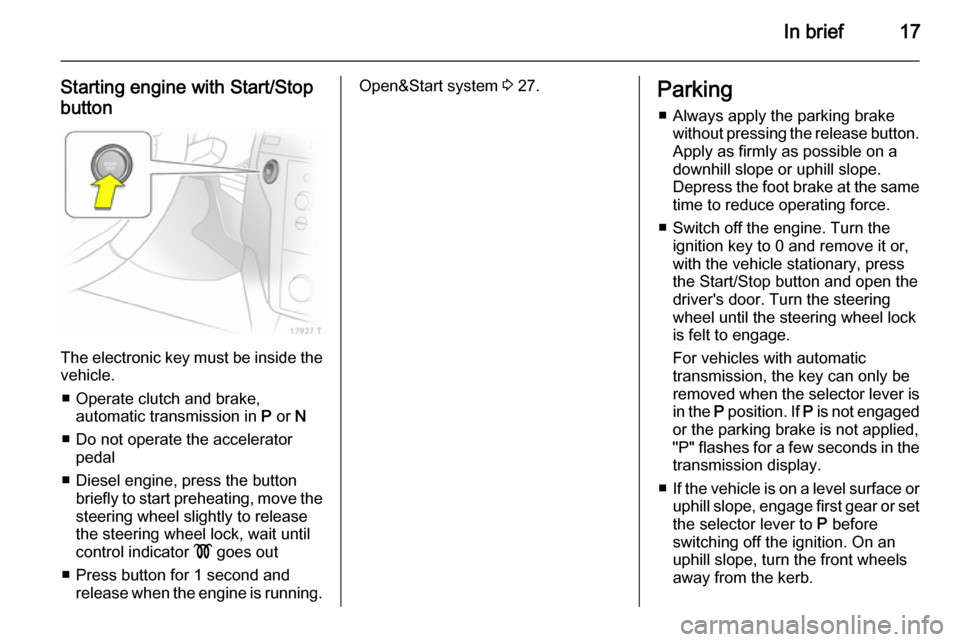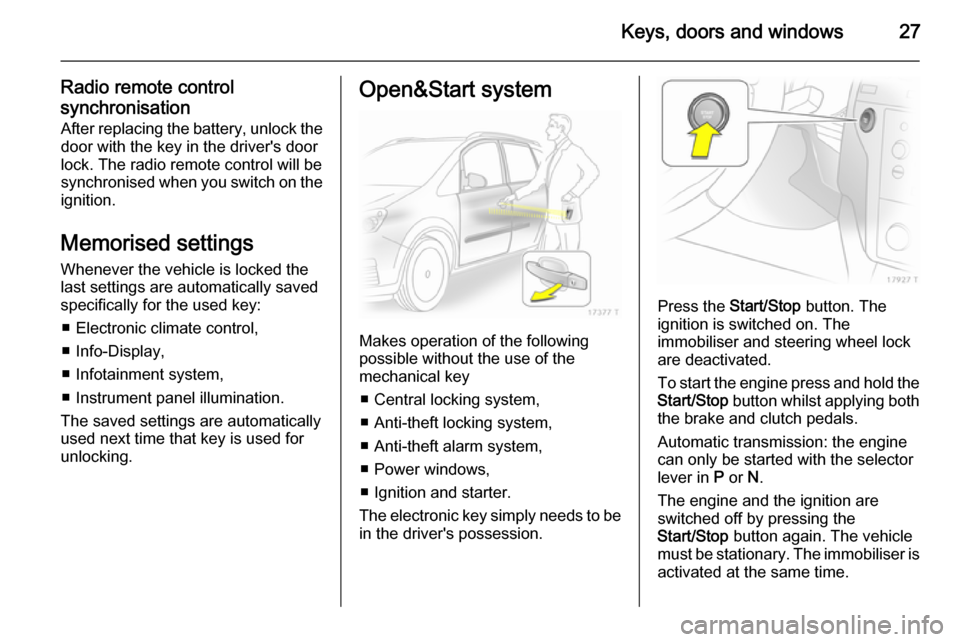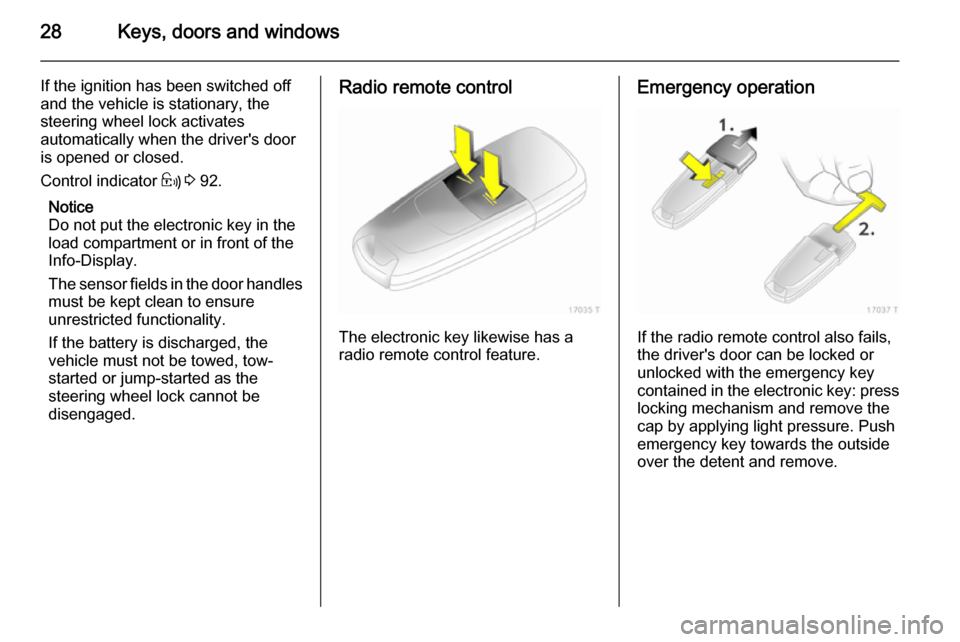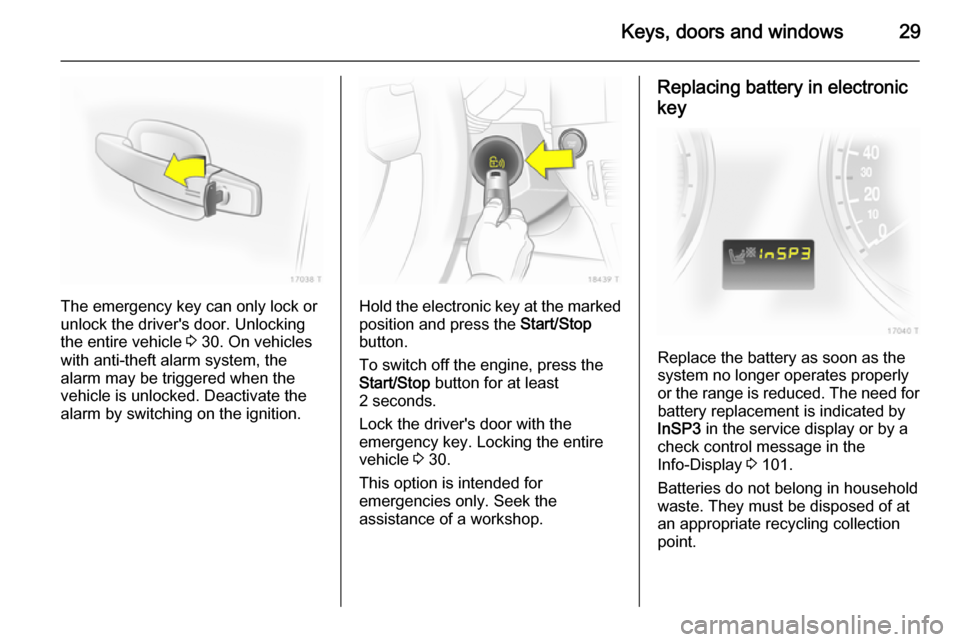display VAUXHALL ZAFIRA 2014.5 Owner's Manual
[x] Cancel search | Manufacturer: VAUXHALL, Model Year: 2014.5, Model line: ZAFIRA, Model: VAUXHALL ZAFIRA 2014.5Pages: 219, PDF Size: 7.83 MB
Page 5 of 219

Introduction3Vehicle specific data
Please enter your vehicle's data on
the previous page to keep it easily
accessible. This information is
available under the sections "Service
and maintenance" and "Technical
data" as well as on the identification
plate.
Introduction
Your vehicle is a designed
combination of advanced technology, safety, environmental friendliness
and economy.
This Owner's Manual provides you
with all the necessary information to
enable you to drive your vehicle
safely and efficiently.
Make sure your passengers are
aware of the possible risk of accident
and injury which may result from
improper use of the vehicle.
You must always comply with the
specific laws and regulations of the
country that you are in. These laws
may differ from the information in this Owner's Manual.When this Owner's Manual refers to aworkshop visit, we recommend your
Vauxhall Authorised Repairer.
All Vauxhall Authorised Repairers provide first-class service at
reasonable prices. Experienced
mechanics trained by Vauxhall work
according to specific Vauxhall
instructions.
The customer literature pack should
always be kept ready to hand in the
vehicle glovebox.
Using this manual ■ This manual describes all options and features available for this
model. Certain descriptions,
including those for display and
menu functions, may not apply to
your vehicle due to model variant,
country specifications, special
equipment or accessories.
■ The "In brief" section will give you an initial overview.
■ The table of contents at the beginning of this manual and withineach section shows where the
information is located.■ The index will enable you to search
for specific information.
■ Yellow arrows in the illustrations serve as points of reference or
indicate some action to be
performed.
■ Black arrows in the illustrations indicate a reaction or a second
action to be performed.
■ This Owner's Manual depicts left- hand drive vehicles. Operation is
similar for right-hand drive vehicles.
■ The Owner's Manual uses the factory engine designations. The
corresponding sales designations
can be found in the section
"Technical data".
■ Directional data, e.g. left or right, or
front or back, always relate to the
direction of travel.
■ The vehicle display screens may not support your specific language.
■ Display messages and interior labelling are written in bold letters.
Page 13 of 219

In brief11
1Light switch ........................ 109
Instrument illumination .......114
Rear fog light ....................... 113
Front fog lights ...................112
Headlight range
adjustment ......................... 110
2 Side air vents ...................... 123
3 Turn and lane-change
signals, headlight flash,
low beam and high beam ...112
Exit lighting .......................... 115
Parking lights ...................... 113
Cruise control ....................... 93
4 Steering wheel controls ........78
5 Horn ...................................... 79
Driver airbag ......................... 60
6 Instruments .......................... 84
7 Windscreen wiper,
windscreen washer
system, headlight washer
system .................................. 79
8 Centre air vents ................... 1239Left heated seat ....................48
Tyre pressure monitoring
system ................................. 176
Ultrasonic parking assist ......90
Hazard warning flashers .....112
Central locking system ..........30
Sport mode ........................... 90
Right heated seat ..................48
10 Info-Display ........................... 94
Trip computer ...................... 103
Electronic climate control
system ................................. 120
11 Front passenger airbag .........60
12 Glovebox .............................. 68
13 Infotainment system ..............10
14 Climate control system ........ 117
15 Selector lever, manual
transmission ....................... 134
Manual transmission
automated ........................... 135
Automatic transmission .......12916Ashtray .................................. 83
17 Start/Stop button .................. 27
18 Accelerator pedal ................125
19 Ignition switch with
steering wheel lock .............126
Sensor panel for
emergency operation of
Open&Start system ..............27
20 Brake pedal ......................... 139
21 Clutch pedal ........................ 125
22 Steering wheel adjustment ...78
23 Bonnet release lever ...........154
Page 19 of 219

In brief17
Starting engine with Start/Stop
button
The electronic key must be inside the
vehicle.
■ Operate clutch and brake, automatic transmission in P or N
■ Do not operate the accelerator pedal
■ Diesel engine, press the button briefly to start preheating, move thesteering wheel slightly to release
the steering wheel lock, wait until
control indicator ! goes out
■ Press button for 1 second and release when the engine is running.
Open&Start system 3 27.Parking
■ Always apply the parking brake without pressing the release button.Apply as firmly as possible on a
downhill slope or uphill slope.
Depress the foot brake at the same
time to reduce operating force.
■ Switch off the engine. Turn the ignition key to 0 and remove it or,
with the vehicle stationary, press
the Start/Stop button and open the
driver's door. Turn the steering
wheel until the steering wheel lock
is felt to engage.
For vehicles with automatic
transmission, the key can only be
removed when the selector lever is in the P position. If P is not engaged
or the parking brake is not applied,
"P" flashes for a few seconds in the transmission display.
■ If the vehicle is on a level surface or
uphill slope, engage first gear or set the selector lever to P before
switching off the ignition. On an
uphill slope, turn the front wheels
away from the kerb.
Page 24 of 219

22In briefActive head restraints on
front seats
In the event of a rear-end impact, the active head restraints tilt forwards
slightly. The head is more effectively
supported by the head restraint and
the risk of whiplash injury is reduced.
Active head restraints can be
recognised by the word ACTIVE.
Head restraints 3 43.
Trip computer
Functions:
■ Range
■ Instantaneous consumption
■ Distance
■ Average speed
■ Absolute consumption
■ Average consumption
■ Stop watch
■ Tyre pressure
Trip computer 3 103, 3 105.
Check control
The check control monitors:
■ Fluid levels
■ Tyre pressure
■ Radio remote control battery
■ Anti-theft alarm system
■ Important exterior lighting bulbs, including cables and fuses.
Display messages 3 101.
Page 25 of 219

In brief23Sport mode
Activate by pressing the SPORT
button.
The Sport mode is used to make
suspension and steering more direct.
The engine is more responsive to
throttle application. With manual
transmission automated and
automatic transmission, gear
changing is altered.
Sport mode 3 141.
FlexOrganizer
The side walls contain retaining
strips, where various components can be attached to divide the load
compartment or fasten loads.
The system consists of: ■ adapters
■ variable partition net
■ mesh pockets for the side walls
■ hooks in the load compartment
FlexOrganizer 3 72.
Tyre pressure monitoring
system
A pressure sensor is integrated in
each wheel to monitor tyre pressure.
Low tyre pressure will be indicated
with a yellow control indicator A. The
current tyre pressure and warning messages may be displayed in the
Info-display.
Tyre pressure monitoring system
3 91, 3 176.
Page 29 of 219

Keys, doors and windows27
Radio remote control
synchronisation After replacing the battery, unlock the
door with the key in the driver's door
lock. The radio remote control will be
synchronised when you switch on the
ignition.
Memorised settings
Whenever the vehicle is locked the
last settings are automatically saved
specifically for the used key:
■ Electronic climate control,
■ Info-Display,
■ Infotainment system,
■ Instrument panel illumination.
The saved settings are automatically
used next time that key is used for
unlocking.Open&Start system
Makes operation of the following
possible without the use of the
mechanical key
■ Central locking system,
■ Anti-theft locking system,
■ Anti-theft alarm system,
■ Power windows,
■ Ignition and starter.
The electronic key simply needs to be in the driver's possession.
Press the Start/Stop button. The
ignition is switched on. The
immobiliser and steering wheel lock
are deactivated.
To start the engine press and hold the
Start/Stop button whilst applying both
the brake and clutch pedals.
Automatic transmission: the engine
can only be started with the selector
lever in P or N.
The engine and the ignition are
switched off by pressing the
Start/Stop button again. The vehicle
must be stationary. The immobiliser is
activated at the same time.
Page 30 of 219

28Keys, doors and windows
If the ignition has been switched off
and the vehicle is stationary, the
steering wheel lock activates
automatically when the driver's door
is opened or closed.
Control indicator 0 3 92.
Notice
Do not put the electronic key in the
load compartment or in front of the
Info-Display.
The sensor fields in the door handles
must be kept clean to ensure
unrestricted functionality.
If the battery is discharged, the
vehicle must not be towed, tow-
started or jump-started as the
steering wheel lock cannot be
disengaged.Radio remote control
The electronic key likewise has a
radio remote control feature.
Emergency operation
If the radio remote control also fails,
the driver's door can be locked or
unlocked with the emergency key
contained in the electronic key: press locking mechanism and remove the
cap by applying light pressure. Push
emergency key towards the outside
over the detent and remove.
Page 31 of 219

Keys, doors and windows29
The emergency key can only lock or
unlock the driver's door. Unlocking the entire vehicle 3 30. On vehicles
with anti-theft alarm system, the
alarm may be triggered when the
vehicle is unlocked. Deactivate the
alarm by switching on the ignition.Hold the electronic key at the marked
position and press the Start/Stop
button.
To switch off the engine, press the
Start/Stop button for at least
2 seconds.
Lock the driver's door with the
emergency key. Locking the entire vehicle 3 30.
This option is intended for
emergencies only. Seek the
assistance of a workshop.
Replacing battery in electronic
key
Replace the battery as soon as the
system no longer operates properly
or the range is reduced. The need for
battery replacement is indicated by
InSP3 in the service display or by a
check control message in the
Info-Display 3 101.
Batteries do not belong in household
waste. They must be disposed of at an appropriate recycling collection
point.
Page 47 of 219

Seats, restraints45Front seats
Seat position9 Warning
Only drive with the seat correctly
adjusted.
■ Sit with buttocks as far back against
the backrest as possible. Adjust the distance between the seat and the
pedals so that legs are slightly
angled when pressing the pedals.
Slide the front passenger seat as
far back as possible.
■ Sit with shoulders as far back against the backrest as possible.
Set the backrest rake so that it is possible to easily reach the
steering wheel with arms slightly bent. Maintain contact between
shoulders and the backrest when
turning the steering wheel. Do not
angle the backrest too far back. We recommend a maximum rake of
approx. 25°.
■ Adjust the steering wheel 3 78.
■ Set seat height high enough to have a clear field of vision on allsides and of all display instruments.
There should be at least one hand
of clearance between head and the
roof frame. Thighs should rest
lightly on the seat without pressing
into it.
■ Adjust the head restraint 3 43.
■ Adjust the height of the seat belt 3 54.■ Adjust the thigh support so that
there is a space approx. two fingers
wide between the edge of the seat
and the hollow of the knee.
■ Adjust the lumbar support so that it
supports the natural shape of the
spine.
Seat adjustment9 Danger
Do not sit nearer than 25 cm from
the steering wheel, to permit safe
airbag deployment.
9 Warning
Never adjust seats while driving as
they could move uncontrollably.
Page 80 of 219

78Instruments and controlsInstruments and
controlsControls ....................................... 78
Warning lights, gauges and indi‐
cators ........................................... 84
Information displays .....................94
Vehicle messages ...................... 101
Trip computer ............................. 103Controls
Steering wheel adjustment
Unlock lever, adjust steering wheel,
then engage lever and ensure it is fully locked.
Do not adjust steering wheel unless
vehicle is stationary and steering
wheel lock has been released.
Steering wheel controls
The Infotainment system and the
Info-Display can be operated via the
controls on the steering wheel.
Further information is available in the
Infotainment system manual.